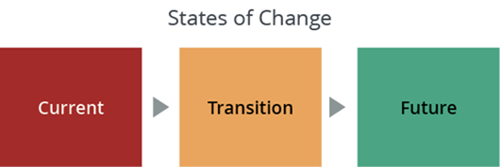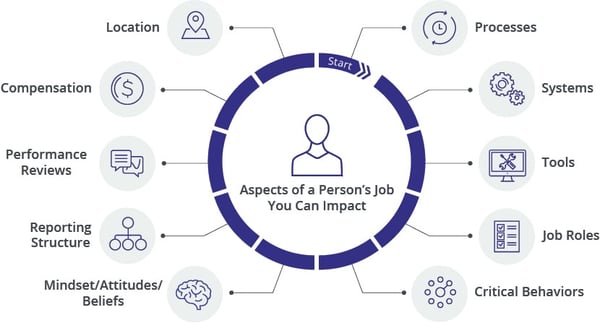Incremental Versus Radical Change

3 Mins
Updated: April 22, 2025
Published: January 5, 2022

The magnitude of a given change will impact how employees react and how you should manage the change. So, how do you assess the disruptive nature of your change?
States of Change as a Measuring Stick
The concept of change occurring across three distinct phases—on both an individual and an organizational level—has been used by countless change management thinkers to understand and more effectively manage change.

In the context of incremental versus radical change, we must consider the following questions:
- How big is the gap between the future state and the current state?
- How different is the future state from the current state?
- How much of a departure from the current state is the future state?
These may seem like simple questions, but they're often overlooked. When planning a project, we tend to focus on the solution itself—which occupies the transition state. When we add a change management perspective, it becomes important to understand just how much change or disruption is taking place because it impacts how we will manage that change.
Think about a project you are working on right now. How would you describe the gap between the current state and the future state? Is it radical, or is it incremental?
Customize Your
Change Management Approach
The nature and size of the change, or the gap between the current state and the future state, impacts how much change management you need. Changes that are incremental in nature typically require less change management because you are asking your employees to take a smaller step from what they know and are comfortable with. Radical changes, on the other hand, require more change management.
In the two scenarios below, think about a project like introducing the Agile method for solutions development:
- Scenario 1 – introducing the Agile method into a technology firm that is comfortable with making quick adaptations to stay on top of industry change
- Scenario 2 – introducing the Agile method into a utility firm that is comfortable with long-term requirements and a waterfall (sequential) approach to solution delivery
For the technology firm, introducing Agile is an incremental change to the way they bring solutions to life. For the utility firm, introducing the Agile method is a radical change, involving new approaches to thinking about requirements and delivering change.
Although you will use the same change management frameworks, such as the ADKAR Model and Prosci Methodology, the two scenarios above require significantly different approaches. The amount of sponsorship required will be different, as will the level of support and personal coaching from people managers. The training and communication will be different. How resistance to change occurs, where it comes from, and how it should be managed will also be different.
 Incremental Versus Radical Change
Incremental Versus Radical Change
for Different Groups
A project may impact different groups in your organization very differently. For some in the organization, the project may only have a small impact on their day-to-day work and processes. For others, the same project may cause tremendous disruption. Each impacted individual has their own current state and their own future state required by the change, and so they have their own gap to bridge.
Here’s how you can recognize the unique journey of each individual while creating an actionable and properly sized change management approach:
1. Conduct sizing assessments
In Prosci's 3-Phase Process, assessing change characteristics as part of the overall risk assessment will help you understand the nature of the change, including scope and how disruptive the change will be be. This is necessary input for customized change management plans.

2. Segment groups and address them specifically and appropriately
Do not treat every group the same way. Adjust your approach based on how the change uniquely impacts individuals and groups. By focusing on the 10 Aspects of Change Impacts, you will build a more complete view of the change and better engage your impacted groups.

3. Customize your approach
Your change management strategy and plans should reflect whether the change is incremental or radical. The size of the disruption of the change will impact your change management plans, including the Communications Plan, Sponsor Plan, People Manager Plan, and Training Plan. You may also need to add or adjust any extend plans you decide to use, such as a Resistance Management Plan. Or you might use only an ADKAR Blueprint. Customize and scale your approach based on the unique impact and qualities of the change.
Customized, Scalable Change Management
A one-size-fits-all approach is not appropriate or effective for change management. You must understand the magnitude, disruption, gap and size of a change to build the right approach. Learn more about creating a customized, scalable change management strategy when you explore the Prosci Methodology.



